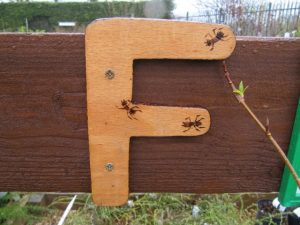Making wooden sorority letters will probably mean making large sorority letters. These could be cut from plywood, foam board, heavy duty foam board, or cardboard and paper. Whatever you have in mind, you will first need to draw or plot your lettering on the material to be cut.
Assuming basic computer skills, you will probably start out with a digital file. Almost all lettering will be in vector format, which is salable without loss of quality. For those wish to go non-digital, use a light box style projector, available from art stores.

Software
Open your lettering in some kind of editing software that can export and edit PDF’s. My choice would be Photoshop because it allows for scaling lettering to any size, although theoretically almost any software that can export to a PDF should be capable of giving the desired results.
The advantage of Photoshop is that it allows you to measure and scale exactly. Once you have your lettering to the correct scale and you have adjusted the spacing between the letters which, for large scale letters will probably not be quite right straight out of the box (default settings), save to a PDF.
Open in Adobe Acrobat or in a similar application software. Printing straight from Photoshop is possible but there are many options that you won’t need (keep it simple). Adobe Acrobat will allow you to print large lettering onto an array or grid of paper sheets, which how you will need to print unless you have access to a large format printer (see printer options). To save time later, allow crop-marks before printing, this lets you line-up and tape your sheets together once printed.
Cutting and Finishing
Now you can either glue your paper lettering on top of your desired base material or transfer your design to the new surface before cutting. There are many ways to do this; some dating back to the Renaissance. The easiest will probably require a visit to a sewing and knitting shop where, if you are lucky, you will find a small tool consisting of a small spiked wheel that rotates on the end of a handle and is used to transfer sewing patterns from thin paper to cardboard.
This is done by rolling the spiked sewing tracing wheel over the pattern on the paper and leaving a little line of pin pricks in the board below. With this simple and cheap tool, you will be able to transfer you design to any flat surface. If you have difficulty in seeing the line of poke marks clearly, rub a little colored chalk dust into them. This makes them more visible. Now you simply need to cut along the line. How you do this will depend on the material in question.
For paper or thin cardboard, use a razor knife. For thick foam, you will need to use a hot wire or band saw. Depending on the scale, you could also use a coping saw. For plywood use a jigsaw and make sure to use top quality blades designed for the type of board and the shapes you will need to follow. You may need a variety of sizes and teeth patterns to achieve best results. Finish with sandpaper and seal or paint with an appropriate coating.




